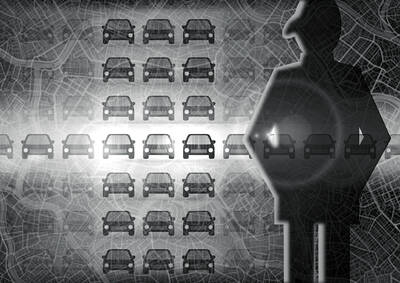Taiwan’s partnerships with Japan in the semiconductor sector is solidifying, as reflected in Taiwan Semiconductor Manufacturing Co’s (TSMC) latest attempt to gear up its global manufacturing footprint expansions. The world’s biggest contract chipmaker last week said that it was “seriously considering” building a second fab in Japan after the construction of its first fab in Kumamoto went smoothly and is scheduled to open on Feb. 24 before cranking out its first chips by the end of this year.
The chipmaker also revealed that it might utilize advanced 7-nanometer technology or less advanced 16-nanometer technology at the second fab, once the expansion plan is finalized. It is widely expected that TSMC would adopt 7-nanometer technology, an upgrade from the 12-nanometer, 16-nanometer, 22-nanometer and 28-nanometer technologies that are to be used to make chips at the first Kumamoto fab.
The chipmaker’s new capacity buildup in Japan is outpacing its expansion in Arizona, a result of the differences in work culture and subsidy grants. TSMC has pushed back the operation date of its second fab in Arizona to 2027, or even 2028, from its original schedule to open in 2026. The chipmaker is still evaluating which technology to deploy there. Previously, the company said it had planned to make 3-nanometer chips at the factory.
Customer demand and a “certain level of government subsidy or support” are two determining factors behind its decisions on where it would build its manufacturing sites and which technologies, or capacity it would deploy, TSMC said. The Japanese government showed stronger ambition to revive its semiconductor industry as the Cabinet in November last year approved a new ¥2 trillion (US$13.52 billion) semiconductor subsidy plan, with ¥900 billion of the amount allocated for TSMC’s second fab in Kumamoto. The subsidy accounts for more than one-third of the fab’s construction cost.
The latest development in TSMC’s new global manufacturing footprint expansions might coincide with founder Morris Chang’s (張忠謀) comment in October last year that Japan and Singapore might have the best chance to rise as winners in the global chip race, given their work culture and abundant supplies of water and electricity.
Although TSMC has said that more than 60 percent of its supplies would come from its Japanese partners, Taiwanese companies are looking at potential opportunities too, as the chipmaker is expected to build two or even three fabs in Japan.
TSMC’s local partners such as Materials Analysis Technology Inc (MA-tek) and Finesse Technology Co have started new capacity expansion plans such as labs or new production lines in Kumamoto. Finesse Technology provides semiconductor equipment and maintenance services to TSMC, while MA-tek provides material and failure analyses.
Local semiconductor companies are not the only ones flocking to Japan; local banks and airlines also see new opportunities in expanding. CTBC Commercial Bank Co’s Japanese subsidiary Tokyo Star Bank has launched an office in Kumamoto, targeting growing corporate loan and housing mortgage demand in the region with the arrival of TSMC, it said last month. CTBC is the second Taiwanese bank to open a branch on Japan’s Kyushu, following E.Sun Commercial Bank.
Overall, Taiwan’s trade partnership with Japan is likely to grow, first in the semiconductor sector and then spreading out into other sectors.
Concerns that the US might abandon Taiwan are often overstated. While US President Donald Trump’s handling of Ukraine raised unease in Taiwan, it is crucial to recognize that Taiwan is not Ukraine. Under Trump, the US views Ukraine largely as a European problem, whereas the Indo-Pacific region remains its primary geopolitical focus. Taipei holds immense strategic value for Washington and is unlikely to be treated as a bargaining chip in US-China relations. Trump’s vision of “making America great again” would be directly undermined by any move to abandon Taiwan. Despite the rhetoric of “America First,” the Trump administration understands the necessity of

US President Donald Trump’s challenge to domestic American economic-political priorities, and abroad to the global balance of power, are not a threat to the security of Taiwan. Trump’s success can go far to contain the real threat — the Chinese Communist Party’s (CCP) surge to hegemony — while offering expanded defensive opportunities for Taiwan. In a stunning affirmation of the CCP policy of “forceful reunification,” an obscene euphemism for the invasion of Taiwan and the destruction of its democracy, on March 13, 2024, the People’s Liberation Army’s (PLA) used Chinese social media platforms to show the first-time linkage of three new

If you had a vision of the future where China did not dominate the global car industry, you can kiss those dreams goodbye. That is because US President Donald Trump’s promised 25 percent tariff on auto imports takes an ax to the only bits of the emerging electric vehicle (EV) supply chain that are not already dominated by Beijing. The biggest losers when the levies take effect this week would be Japan and South Korea. They account for one-third of the cars imported into the US, and as much as two-thirds of those imported from outside North America. (Mexico and Canada, while
The military is conducting its annual Han Kuang exercises in phases. The minister of national defense recently said that this year’s scenarios would simulate defending the nation against possible actions the Chinese People’s Liberation Army (PLA) might take in an invasion of Taiwan, making the threat of a speculated Chinese invasion in 2027 a heated agenda item again. That year, also referred to as the “Davidson window,” is named after then-US Indo-Pacific Command Admiral Philip Davidson, who in 2021 warned that Chinese President Xi Jinping (習近平) had instructed the PLA to be ready to invade Taiwan by 2027. Xi in 2017